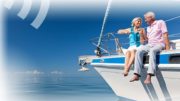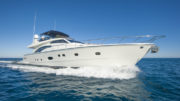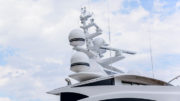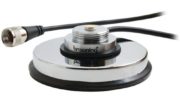If you’ve ever experienced a boat fire, it’s an experience you’ll never forget. The flames can quickly spread through your ship and even damage it beyond repair. Because this is so serious, we urge all captains and crews to be prepared if a blaze breaks out on board. You’ll have to know what to do to put the fire out, and have the equipment you need to do it. Are you and your crew ready to put out a boat fire if it breaks out? If you’re not sure, or need a refresher, check out these marine firefighting tips from Signal Connect.
Boat Fire Extinguishers
How much do you know about fires? In order for one to exist, fires require a combustible material or fuel, oxygen, and a source of ignition or heat. To extinguish a fire, you must permanently deprive the fire of one or more of these elements. The key is using the right extinguisher. Fire extinguishers are classified by letters and numbers according to the class and size of fire they can put out. The letter (A, B, C, D) indicates the class, and the number measures the capacity of the extinguisher. (The bigger the number, the greater the capacity of extinguishing material it contains.)
To make sure you’re well prepared, here’s a breakdown of the various types of fires and the fire extinguishers you should use for them:
- Type-A Fires: These involve solids, such as wood, paper, textiles, and plastics. If you encounter this type of fire, use a Class A-rated fire extinguisher. (Note: Don’t use Class A extinguishers on liquid, gas, or electrical fires.)
- Type-B Fires: These blazes involve combustible or flammable liquids or gases, such as gasoline, diesel, kerosene, grease, or oil. For these fires, you need a Class-B fire extinguishers.
- Type-C Fires: These involve flammable gases. Use a Class-B extinguisher.
- Type-D: Fires involving combustible metals such as titanium, potassium, sodium, and magnesium. When you encounter these situations, you need a Class-D extinguisher. (Note: These extinguishers are typically found in the engineering department.)
- Class-E Fires: These are better known as electrical fires. If one of these breaks out on your boat, you have two choices: cut the power and use a Class A, B, C, or D extinguisher, or leave the connection live and use a Class-C extinguisher.
- Type-F Fires: These are fires fueled by cooking oils, fats, or trans-fats. Use a Class-B extinguishers, which should be kept in the galley and food-service areas.
All the knowledge in the world won’t save your boat if you don’t actually have the fire extinguishers in your craft. And by fire extinguishers, we mean that you have to make sure you have enough of each type of these devices on your boat. Make sure to put each fire extinguisher in a location that has a risk of that type of fire. For example, a Type-D fire extinguisher is best placed in your engineering department while a Class-B extinguisher belong in the kitchen.
Using a Fire Extinguisher on Board
In the event that a fire starts on your boat, here are the steps you and your crew need to take to extinguish the blaze:
- Stop the boat’s engine immediately.
- Position the boat so that the wind blows the fire away from it. This helps prevent the fire from spreading and minimizes smoke inhalation.
- Separate the fuel source from the fire if possible.
- Grab you’re the correct fire extinguisher and pull the pin, aim the extinguisher at base of fire, squeeze two levers together, and sweep the extinguisher from side to side until the fire is extinguished.
Firefighting Equipment for Boats
Fire extinguishers are absolutely important to have on your boat. As crucial as these are for your boat, there is other firefighting equipment that’s equally important. Here is a short list of the items you should have on your boat in case a fire breaks out:
- Fire extinguishers of all classes
- Fire blankets
- Parat C or similar escape sets
- SCBA sets for use in machinery spaces
- Fire retardant suits
- Emergency breathing devices
- Flares and smoke signals
- Immersion/survival suits
- Waterproof glow sticks
- Life buoys or life rings
- Stretchers
- First-aid kits and medical supplies
It’s not enough to have this equipment on board. You and your crew need to know how to find these things in an emergency. More importantly, you also need to know how to use all of this equipment. There’s only one way to be assured that you and your crew know how to properly fight a boat fire, and that’s having proper training. This training is part of every good marine fire prevention program for your ship.
Bonus Tip: DIRECTV for Boats
If there’s no fire on board, and you’ve done all you can to prevent fires, you can sit back and relax a bit. There’s no better way for you, your guests, and crew to do this than enjoying your favorite shows on DIRECTV. Getting satellite TV service on your luxury craft or service vessel is easier than you might think. Signal Connect is an DIRECTV for Business dealer. We specialize in helping our clients get DIRECTV on their boats. Would you like to bring your favorite programs to your ship in high-definition resolution? Call Signal Connect at 888-233-7563. We’re happy to answer any question you have about marine DIRECTV.





